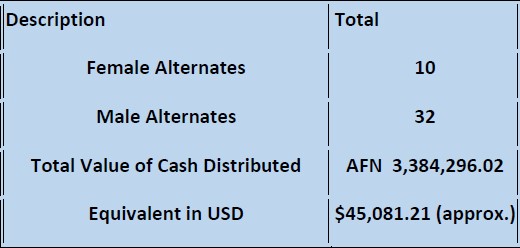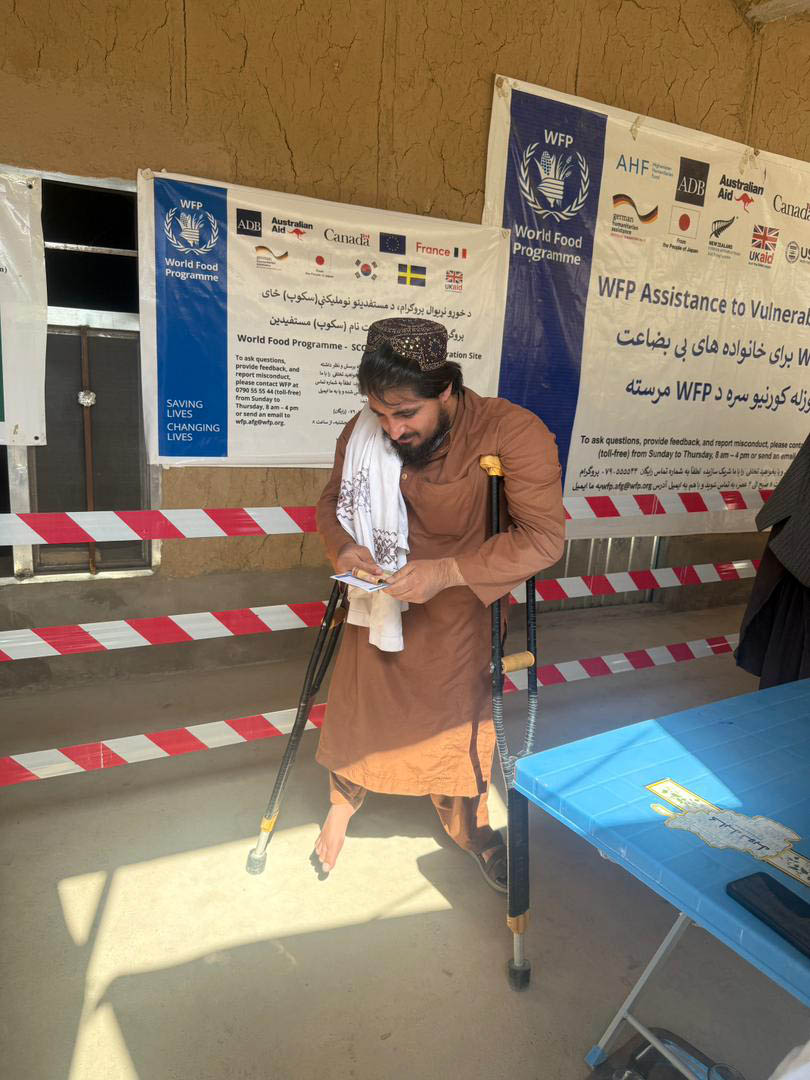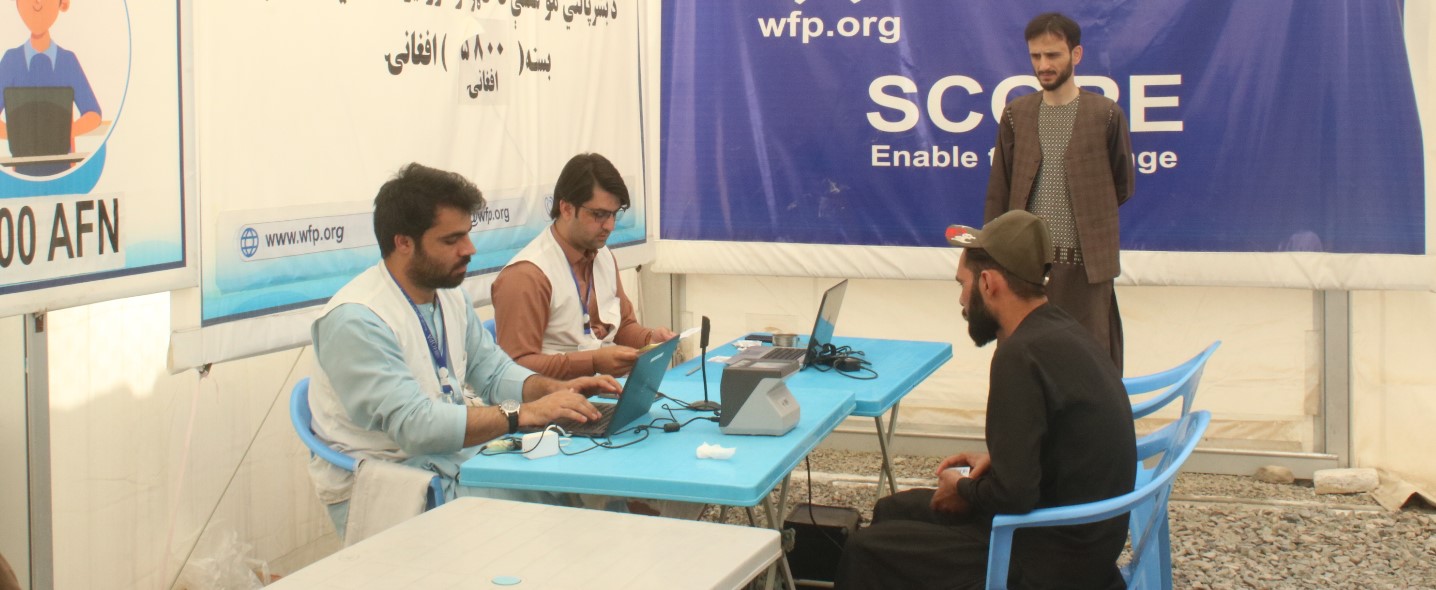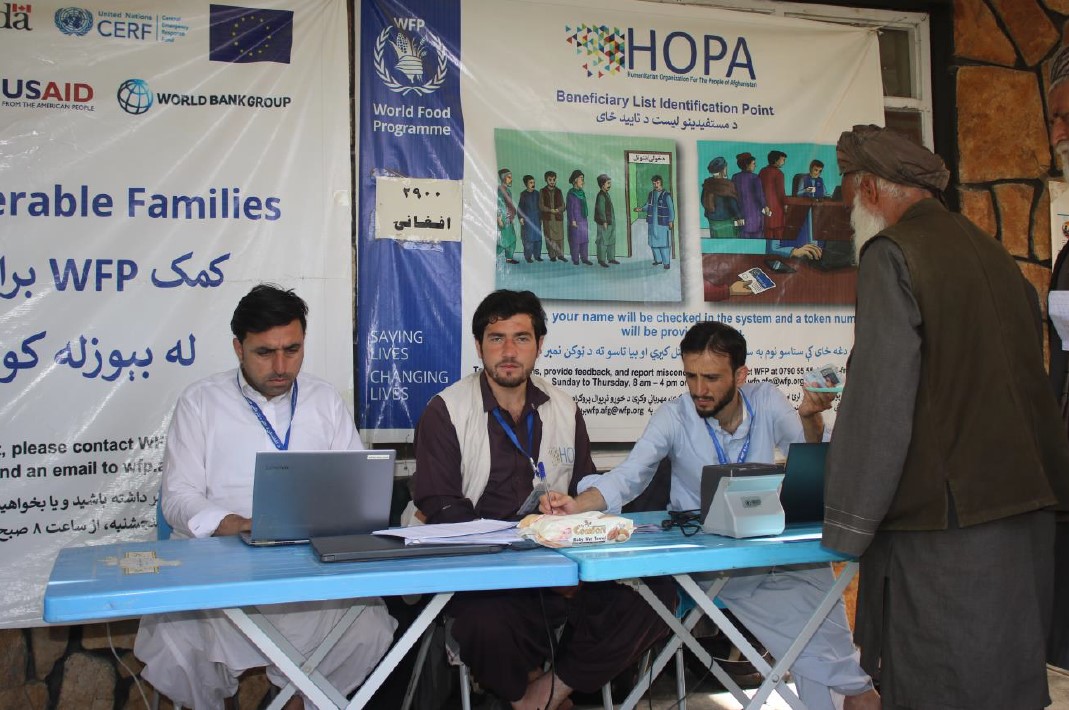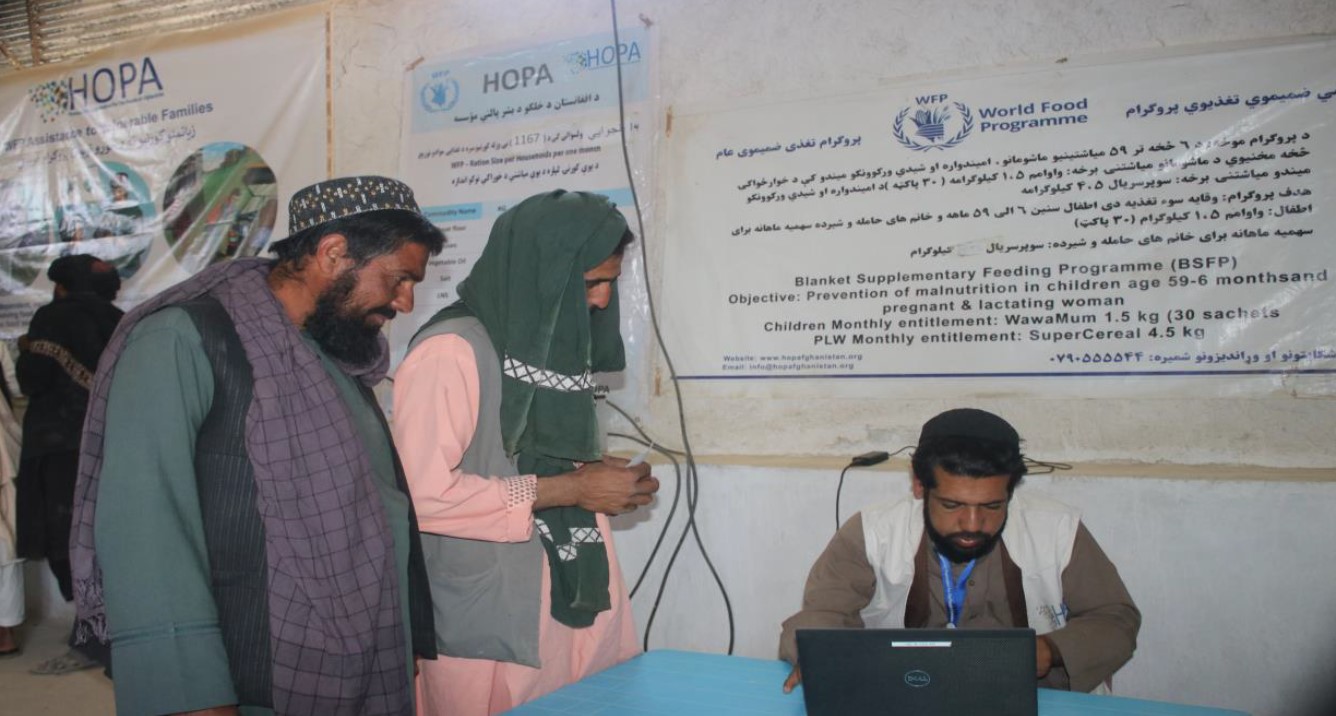
Cash-Based Transfers (CBT) and Food Distribution
01. Introduction
The Humanitarian Organization for the People of Afghanistan (HOPA), in partnership with the World Food Programme (WFP), successfully completed the 6th cycle of Cash-Based Transfer (CBT) and Food Assistance (BSFP) in Panjwayi District, Kandahar Province from 24 to 29 April 2025.
This round of distribution aimed to support food security and nutritional outcomes for vulnerable households through a combination of direct food voucher distribution and specialized nutritional support. The activity was carried out at the Panjwayi Central Point, ensuring accessibility and safety for all beneficiaries.
A total of 1,167 out of 1,167 households received direct cash assistance through this program, total value of distributed vouchers 24,580,400 Afghanis (AFN), equivalent to 354,087.50 (approx.) USD. The distribution was carried out in a fair, transparent, and organized manner, ensuring that all eligible beneficiaries, including female-headed households and persons with disabilities, received their entitlements without difficulty.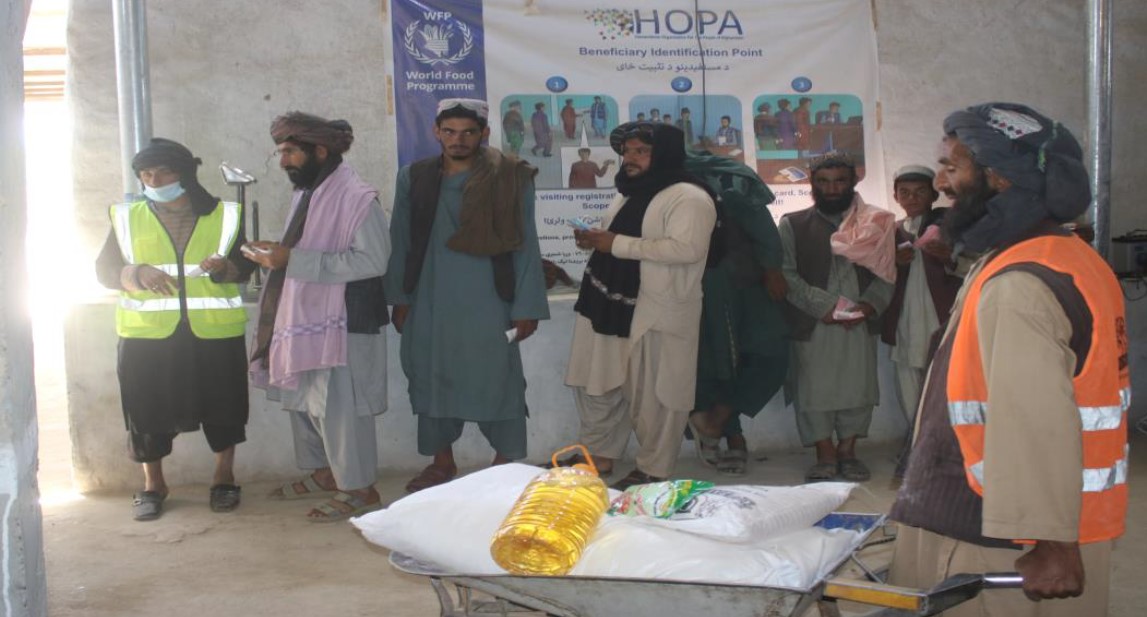
02. Distribution Overview
The total planned number of households for this cycle was 8,488, out of which 8,476 successfully received their cash assistance.
Planned Households: 1,167
Actual Households Served: 1,167
Absentees: 0
03. Nutritional Support – LNS and WSB Distribution
In addition to the cash distribution, nutritional support was also provided, benefiting a significant number of children and pregnant and breastfeeding women (PBW). A breakdown of the nutritional support is provided below:
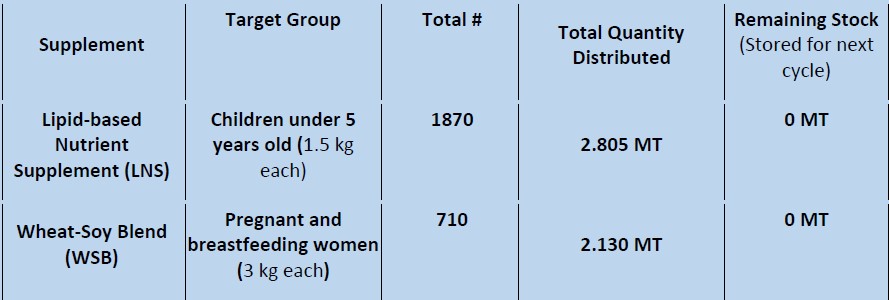
04. Protection and Risk Mitigation Measures
4.1 Gender and Disability Inclusion
Separate queues and distribution points were established for men and women.
Female staff managed women’s sections, enhancing comfort and privacy.
Priority support was given to persons with disabilities and the elderly.
4.2 Protection from Sexual Exploitation and Abuse (PSEA)
All staff were oriented on PSEA policies.
No cases of SEA were reported.
4.3 Accountability to Affected Populations (AAP)
Feedback desks were active at all sites.
Beneficiaries were informed of their entitlements and complaint mechanisms.
Feedback was gathered and responded to promptly.
4.4 Data Security and Card Issues
No lost vouchers or SCOPE cards were reported.
Beneficiary verification was completed through SCOPE and paper ID checks.
3 new households were registered and served during this cycle.
05. Observations and Challenges
5.1 Rush at Voucher Distribution Point:
Shortage of personnel from Gulzad Group led to increased crowding and delays at the voucher issuance counter during peak hours.
Additional coordination and early-stage deployment of adequate staffing is recommended for future cycles.
06. Gender-Segregated Distribution Approach
During the March 2025 cycle of the Cash-Based Transfer (CBT) distribution in Kandahar City, HOPA implemented a fully segregated distribution process, ensuring a culturally sensitive, efficient, and transparent system. The decision to segregate male and female beneficiaries for the entire distribution cycle, from registration to voucher issuance, was driven by the goal of enhancing accessibility and security for women while maintaining smooth operations. By assigning separate sites and staff for male and female distributions, HOPA respected the community's cultural norms and created a more inclusive and respectful environment for beneficiaries.
Key Features of the Segregated Distribution Process:
Separate Distribution Sites and Staff:
Female-headed households (HH) were assigned to a designated area with separate staff.
Male-headed households (HH) were directed to separate distribution areas, where staff handled their needs, maintaining cultural propriety and ensuring privacy.
Benefits for Female Beneficiaries:
The segregated system significantly improved the participation of women, particularly female-headed households. It ensured that they felt secure and respected during the process, encouraging them to engage fully in the distribution.
Many female beneficiaries appreciated the clear separation, as it removed the discomfort associated with mixed-gender interactions in a traditionally conservative environment.
Community Feedback:
Both male and female beneficiaries expressed their satisfaction with the segregated model. Female-headed households, in particular, felt more empowered to collect the assistance without the risk of judgment or harassment.
Community leaders and elders also praised HOPA's approach, recognizing it as a culturally appropriate measure that respected local customs while addressing the needs of the community.
The impact of the segregated process extended beyond comfort and security; it also contributed to significant operational improvements. The division between male and female lines minimized waiting times and overcrowding, making the entire distribution process faster and more organized. Beneficiaries moved through the lines more efficiently, and with fewer disruptions, the distribution cycle proceeded smoothly.
Efficiency and Time Management:
Reduction in Waiting Times:
By creating separate lines for male and female beneficiaries, HOPA improved the flow of the distribution process, ensuring that beneficiaries spent less time waiting for their vouchers or cash.
The gender-segregated approach reduced bottlenecks and allowed for better management of the crowd, particularly during peak distribution times.
Better Queue Management:
Each distribution site had a designated staff member responsible for managing the queue, ensuring that beneficiaries received assistance promptly and that there were no delays due to confusion or mismanagement.
Reduced Time Consumption:
The entire process was completed more quickly compared to previous distributions. This was due to clearer divisions, faster management of individual groups, and a more organized flow of participants.
Transparency and Accountability:
Improved Monitoring and Reporting:
The segregated process allowed for more transparent monitoring of the distribution. With clear distinctions between the two groups, there was less chance of overlap or misreporting, ensuring that each beneficiary received the correct amount of assistance.
Monitoring teams, which were also gender-balanced, contributed to maintaining high standards of accountability and reduced the risk of fraud or favoritism.
Feedback Mechanisms:
A robust feedback system was in place, allowing beneficiaries to voice concerns and suggestions. This helped identify and address any issues promptly, ensuring continuous improvement for future distributions.
07. Financial Summary
No discrepancies or financial irregularities reported.
Reconciliation and reporting were completed in coordination with WFP field teams.
08. Recommendations
Sustain Community Mobilization: Continue pre-distribution awareness to maintain full attendance.
Enhance Disability Access: Improve physical infrastructure (e.g., ramps, shaded waiting areas).
Feedback Enhancement: Introduce post-distribution satisfaction surveys to better tailor services.
Reinforce Gender Segregation: Maintain culturally sensitive spaces with clear signage and staff roles.
Extend TPM Engagement: Invite TPM teams to cover remote and vulnerable sub-locations.
09. Conclusion
The April 2025 CBT and BSFP distribution cycle in Panjwayi District was successfully executed by HOPA in alignment with WFP standards. A total of 1,167 households received food assistance through direct vouchers and commodity support. The process was well-organized, inclusive, and free of technical or protection-related incidents.
The success of this cycle underscores the value of strong community coordination, gender-sensitive practices, and robust field management. HOPA remains committed to continuous improvement and effective humanitarian delivery in the region.

